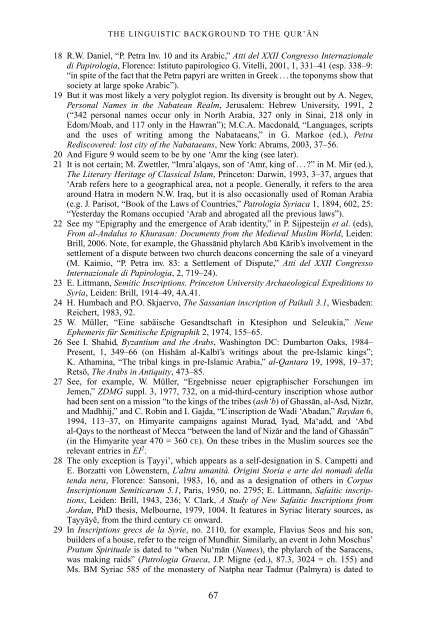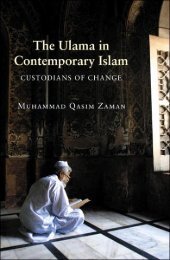The Qur'an in its historical context (pdf - Islam and Christian-Muslim ...
The Qur'an in its historical context (pdf - Islam and Christian-Muslim ...
The Qur'an in its historical context (pdf - Islam and Christian-Muslim ...
You also want an ePaper? Increase the reach of your titles
YUMPU automatically turns print PDFs into web optimized ePapers that Google loves.
THE LINGUISTIC BACKGROUND TO THE QUR’AN<br />
18 R.W. Daniel, “P. Petra Inv. 10 <strong>and</strong> <strong>its</strong> Arabic,” Atti del XXII Congresso Internazionale<br />
di Papirologia, Florence: Istituto papirologico G. Vitelli, 2001, 1, 331–41 (esp. 338–9:<br />
“<strong>in</strong> spite of the fact that the Petra papyri are written <strong>in</strong> Greek...the toponyms show that<br />
society at large spoke Arabic”).<br />
19 But it was most likely a very polyglot region. Its diversity is brought out by A. Negev,<br />
Personal Names <strong>in</strong> the Nabatean Realm, Jerusalem: Hebrew University, 1991, 2<br />
(“342 personal names occur only <strong>in</strong> North Arabia, 327 only <strong>in</strong> S<strong>in</strong>ai, 218 only <strong>in</strong><br />
Edom/Moab, <strong>and</strong> 117 only <strong>in</strong> the Hawran”); M.C.A. Macdonald, “Languages, scripts<br />
<strong>and</strong> the uses of writ<strong>in</strong>g among the Nabataeans,” <strong>in</strong> G. Markoe (ed.), Petra<br />
Rediscovered: lost city of the Nabataeans, New York: Abrams, 2003, 37–56.<br />
20 And Figure 9 would seem to be by one ‘Amr the k<strong>in</strong>g (see later).<br />
21 It is not certa<strong>in</strong>; M. Zwettler, “Imra’alqays, son of ‘Amr, k<strong>in</strong>g of...?” <strong>in</strong> M. Mir (ed.),<br />
<strong>The</strong> Literary Heritage of Classical <strong>Islam</strong>, Pr<strong>in</strong>ceton: Darw<strong>in</strong>, 1993, 3–37, argues that<br />
‘Arab refers here to a geographical area, not a people. Generally, it refers to the area<br />
around Hatra <strong>in</strong> modern N.W. Iraq, but it is also occasionally used of Roman Arabia<br />
(e.g. J. Parisot, “Book of the Laws of Countries,” Patrologia Syriaca 1, 1894, 602, 25:<br />
“Yesterday the Romans occupied ‘Arab <strong>and</strong> abrogated all the previous laws”).<br />
22 See my “Epigraphy <strong>and</strong> the emergence of Arab identity,” <strong>in</strong> P. Sijpesteijn et al. (eds),<br />
From al-Andalus to Khurasan: Documents from the Medieval <strong>Muslim</strong> World, Leiden:<br />
Brill, 2006. Note, for example, the Ghassanid phylarch Abu Karib’s <strong>in</strong>volvement <strong>in</strong> the<br />
settlement of a dispute between two church deacons concern<strong>in</strong>g the sale of a v<strong>in</strong>eyard<br />
(M. Kaimio, “P. Petra <strong>in</strong>v. 83: a Settlement of Dispute,” Atti del XXII Congresso<br />
Internazionale di Papirologia, 2, 719–24).<br />
23 E. Littmann, Semitic Inscriptions. Pr<strong>in</strong>ceton University Archaeological Expeditions to<br />
Syria, Leiden: Brill, 1914–49, 4A.41.<br />
24 H. Humbach <strong>and</strong> P.O. Skjaervo, <strong>The</strong> Sassanian <strong>in</strong>scription of Paikuli 3.1, Wiesbaden:<br />
Reichert, 1983, 92.<br />
25 W. Müller, “E<strong>in</strong>e sabäische Ges<strong>and</strong>tschaft <strong>in</strong> Ktesiphon und Seleukia,” Neue<br />
Ephemeris für Semitische Epigraphik 2, 1974, 155–65.<br />
26 See I. Shahid, Byzantium <strong>and</strong> the Arabs, Wash<strong>in</strong>gton DC: Dumbarton Oaks, 1984–<br />
Present, 1, 349–66 (on Hisham al-Kalbi’s writ<strong>in</strong>gs about the pre-<strong>Islam</strong>ic k<strong>in</strong>gs”;<br />
K. Atham<strong>in</strong>a, “<strong>The</strong> tribal k<strong>in</strong>gs <strong>in</strong> pre-<strong>Islam</strong>ic Arabia,” al-Qantara 19, 1998, 19–37;<br />
Retsö, <strong>The</strong> Arabs <strong>in</strong> Antiquity, 473–85.<br />
27 See, for example, W. Müller, “Ergebnisse neuer epigraphischer Forschungen im<br />
Jemen,” ZDMG suppl. 3, 1977, 732, on a mid-third-century <strong>in</strong>scription whose author<br />
had been sent on a mission “to the k<strong>in</strong>gs of the tribes (ash‘b) of Ghassan, al-Asd, Nizar,<br />
<strong>and</strong> Madhhij,” <strong>and</strong> C. Rob<strong>in</strong> <strong>and</strong> I. Gajda, “L’<strong>in</strong>scription de Wadi ‘Abadan,” Raydan 6,<br />
1994, 113–37, on Himyarite campaigns aga<strong>in</strong>st Murad, Iyad, Ma‘add, <strong>and</strong> ‘Abd<br />
al-Qays to the northeast of Mecca “between the l<strong>and</strong> of Nizar <strong>and</strong> the l<strong>and</strong> of Ghassan”<br />
(<strong>in</strong> the Himyarite year 470 = 360 CE). On these tribes <strong>in</strong> the <strong>Muslim</strong> sources see the<br />
relevant entries <strong>in</strong> EI 2 .<br />
28 <strong>The</strong> only exception is Tayyi’, which appears as a self-designation <strong>in</strong> S. Campetti <strong>and</strong><br />
E. Borzatti von Löwenstern, L’altra umanità. Orig<strong>in</strong>i Storia e arte dei nomadi della<br />
tenda nera, Florence: Sansoni, 1983, 16, <strong>and</strong> as a designation of others <strong>in</strong> Corpus<br />
Inscriptionum Semiticarum 5.1, Paris, 1950, no. 2795; E. Littmann, Safaitic <strong>in</strong>scriptions,<br />
Leiden: Brill, 1943, 236; V. Clark, A Study of New Safaitic Inscriptions from<br />
Jordan, PhD thesis, Melbourne, 1979, 1004. It features <strong>in</strong> Syriac literary sources, as<br />
Tayyayê, from the third century CE onward.<br />
29 In Inscriptions grecs de la Syrie, no. 2110, for example, Flavius Seos <strong>and</strong> his son,<br />
builders of a house, refer to the reign of Mundhir. Similarly, an event <strong>in</strong> John Moschus’<br />
Pratum Spirituale is dated to “when Nu‘man (Names), the phylarch of the Saracens,<br />
was mak<strong>in</strong>g raids” (Patrologia Graeca, J.P. Migne (ed.), 87.3, 3024 = ch. 155) <strong>and</strong><br />
Ms. BM Syriac 585 of the monastery of Natpha near Tadmur (Palmyra) is dated to<br />
67



